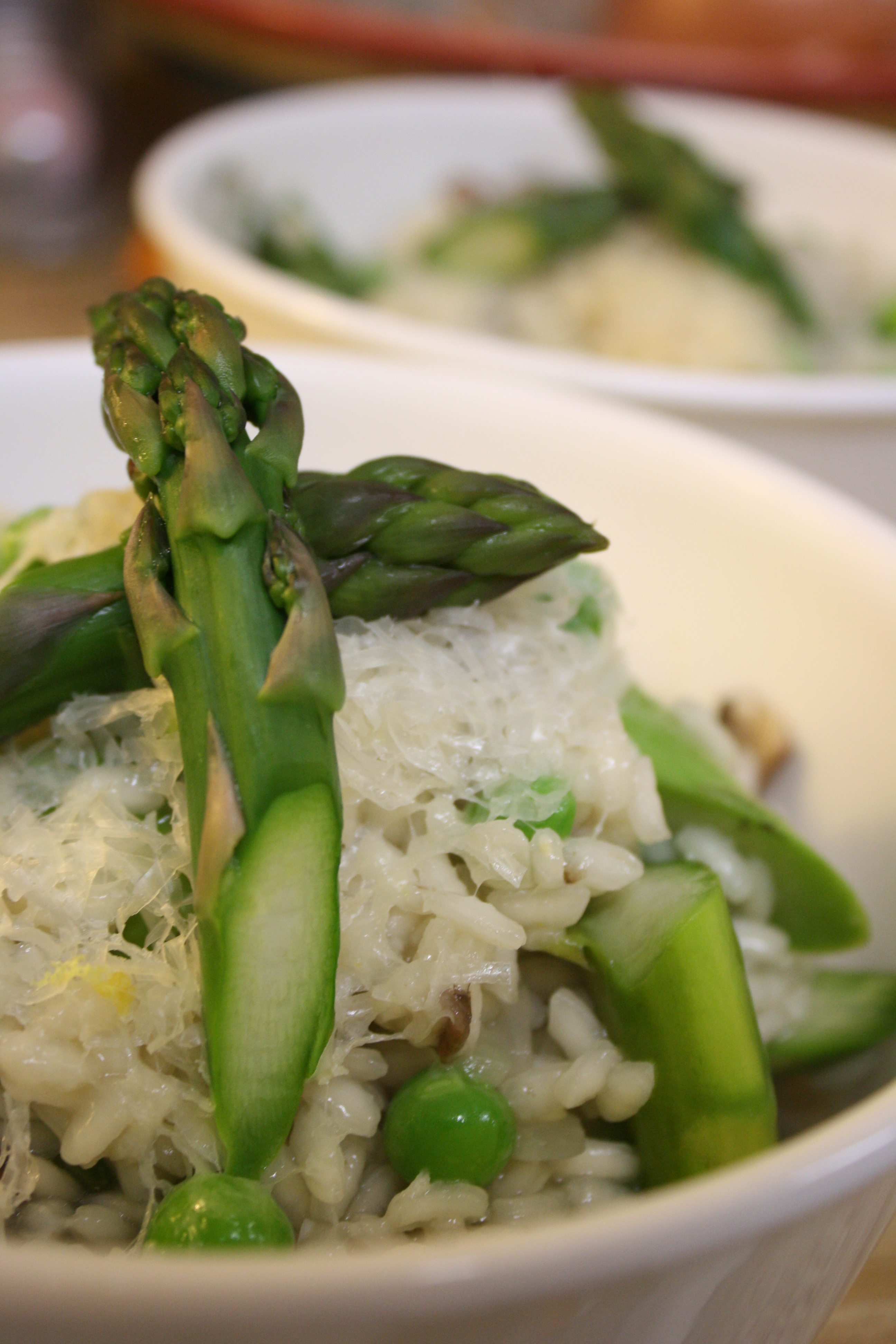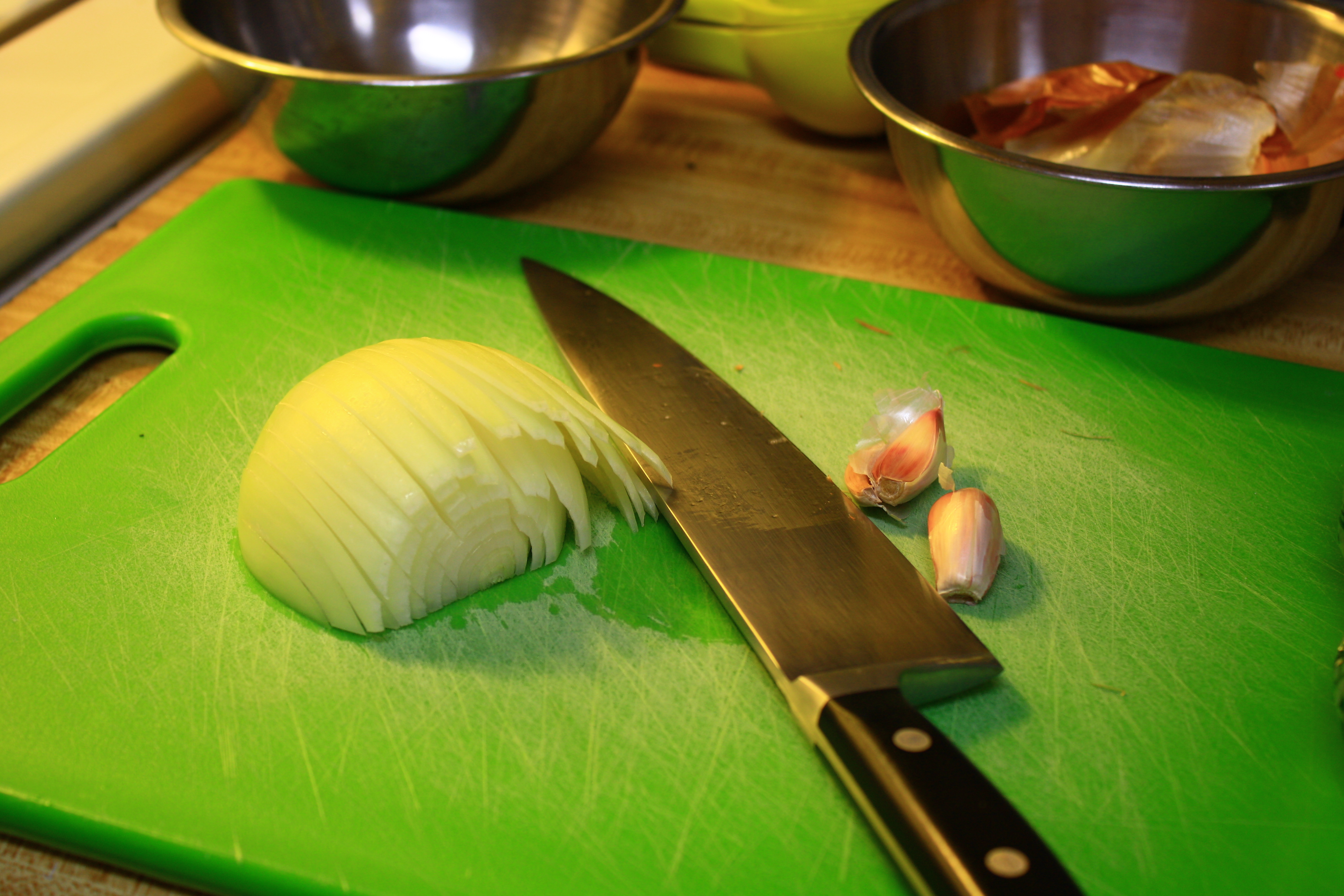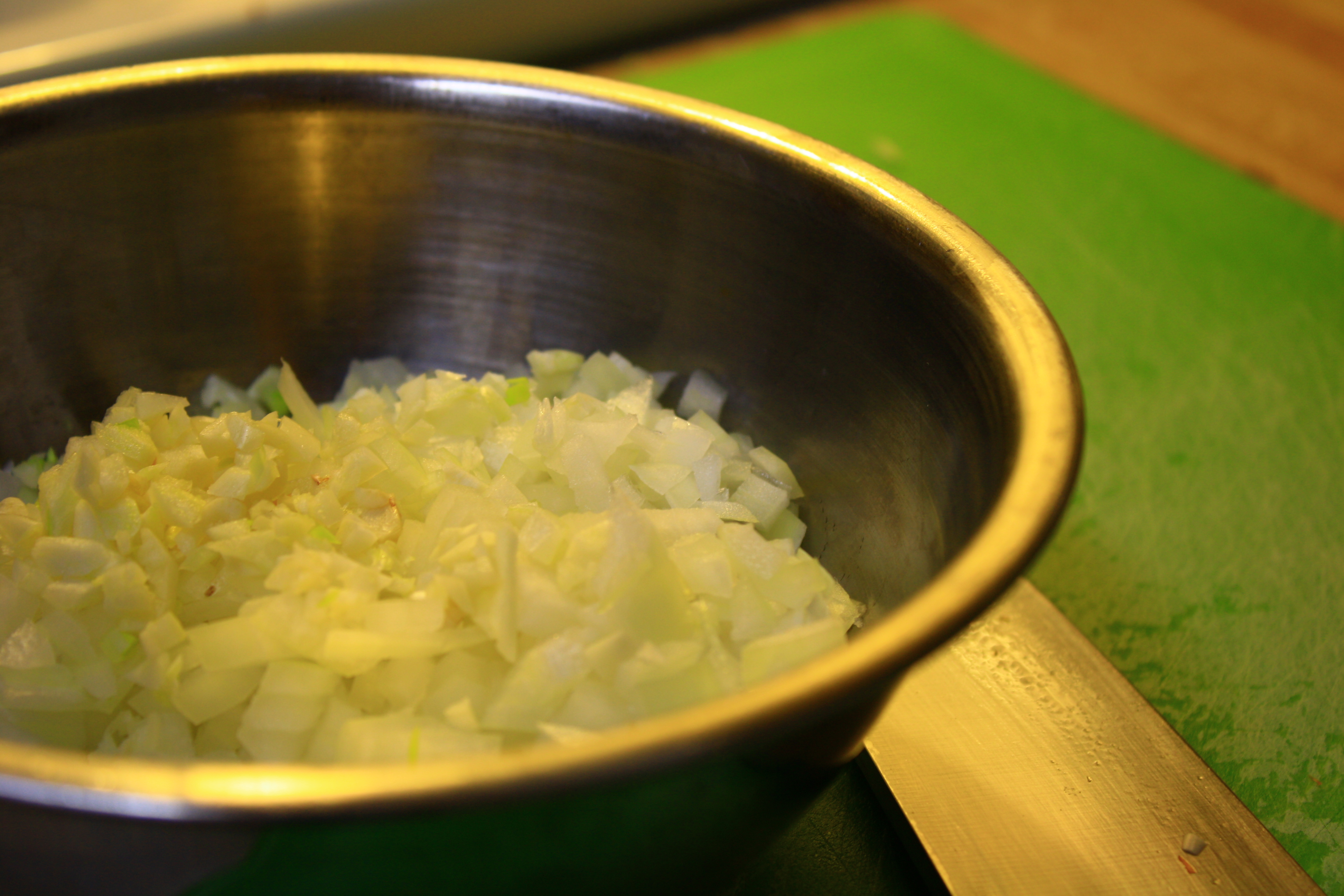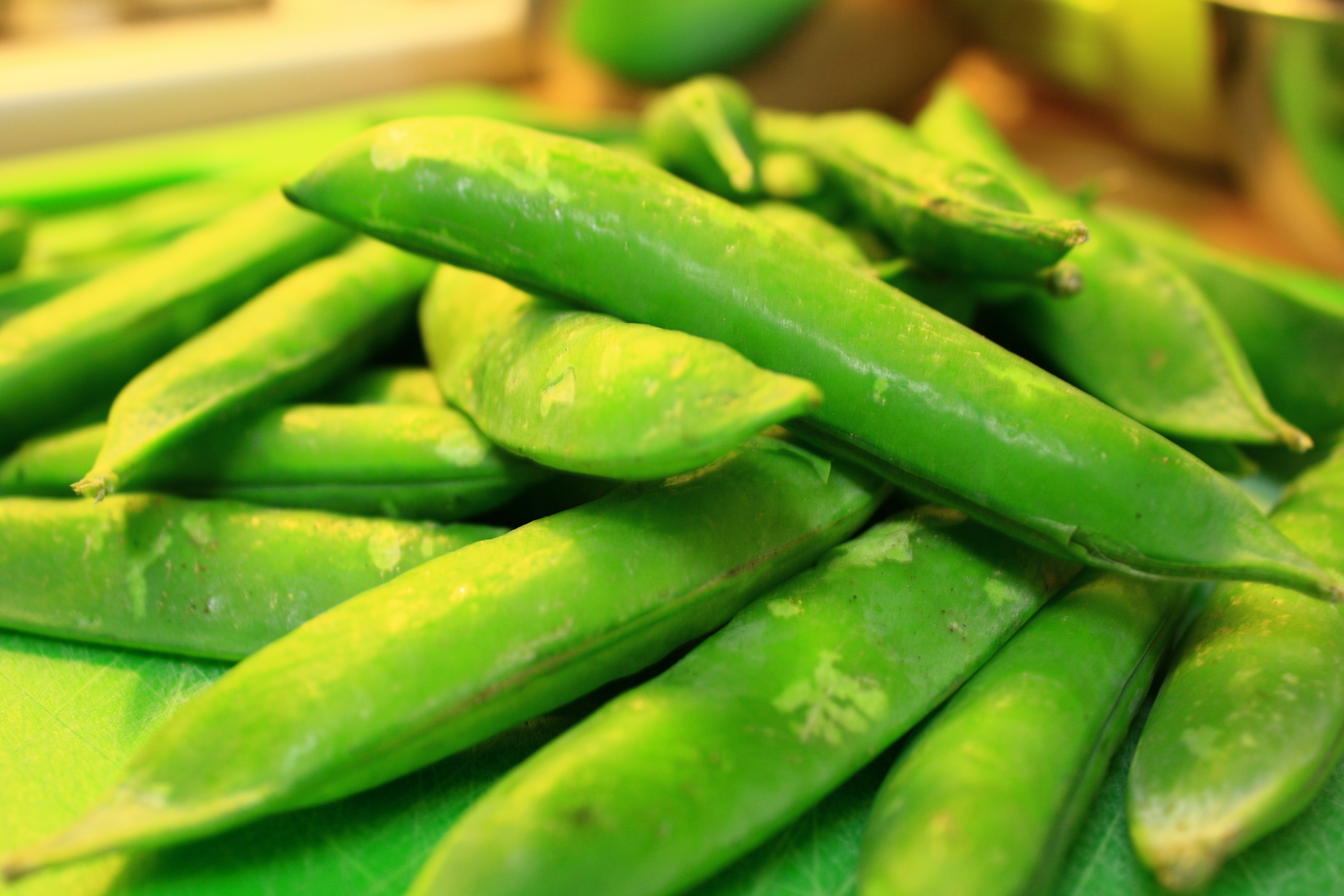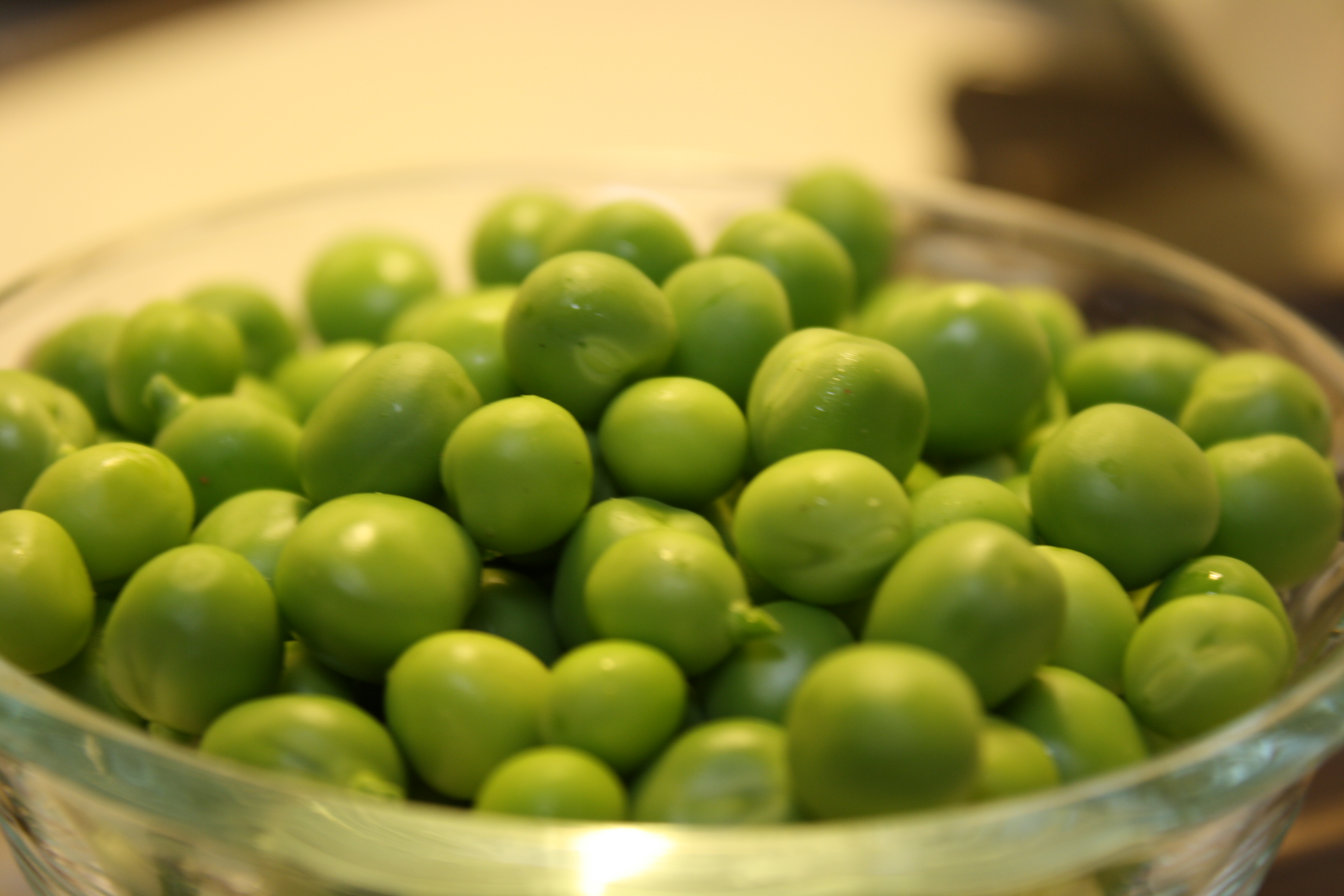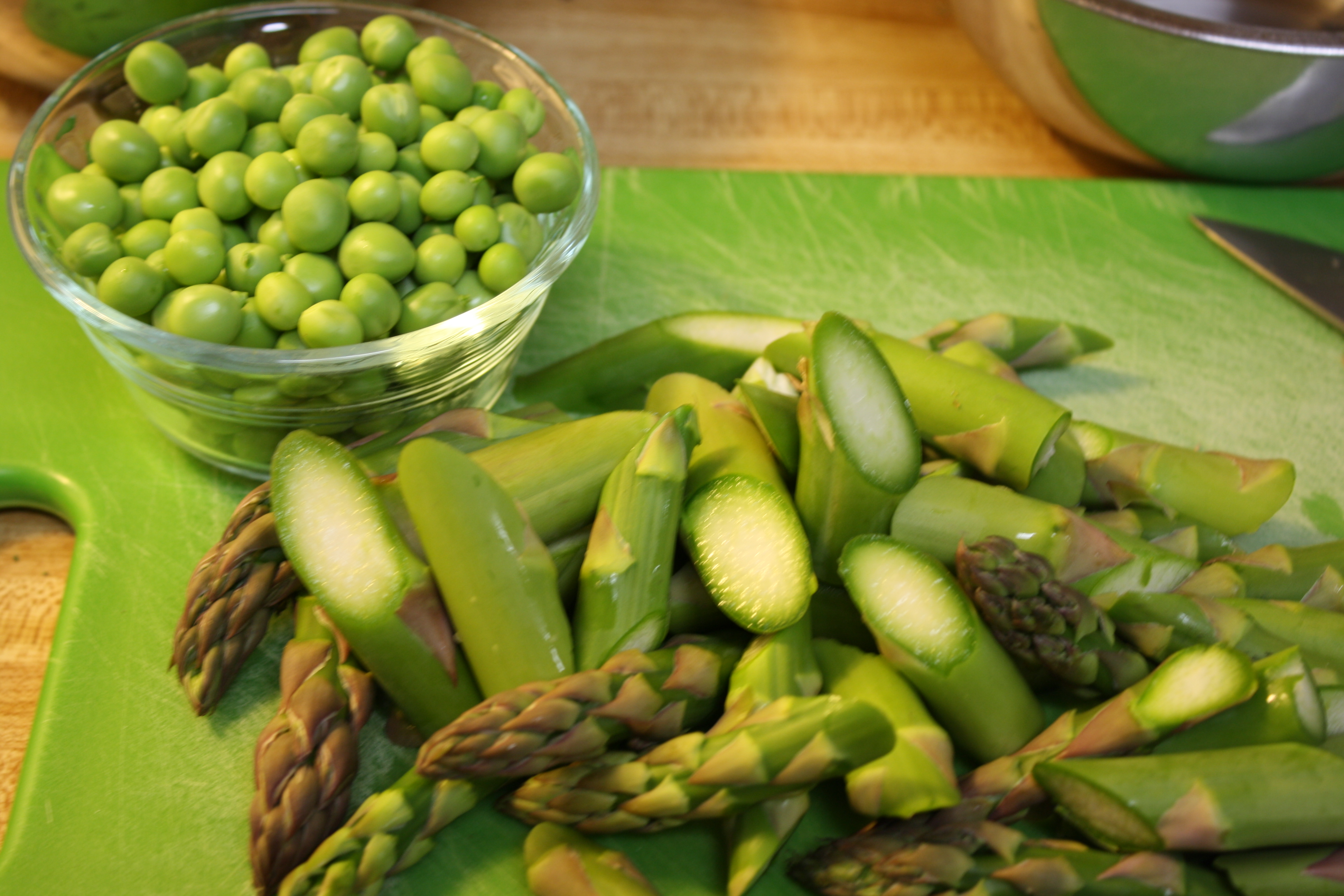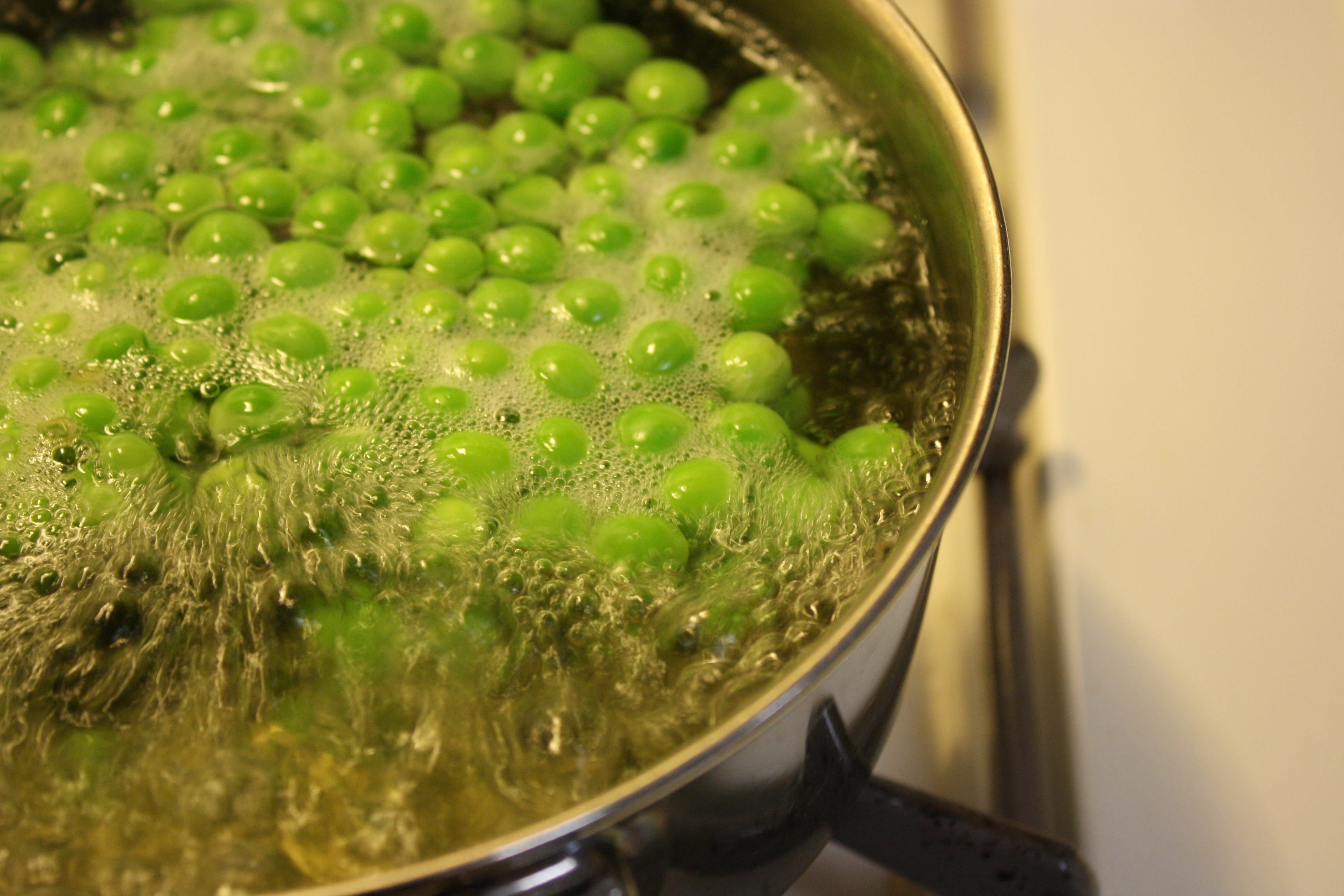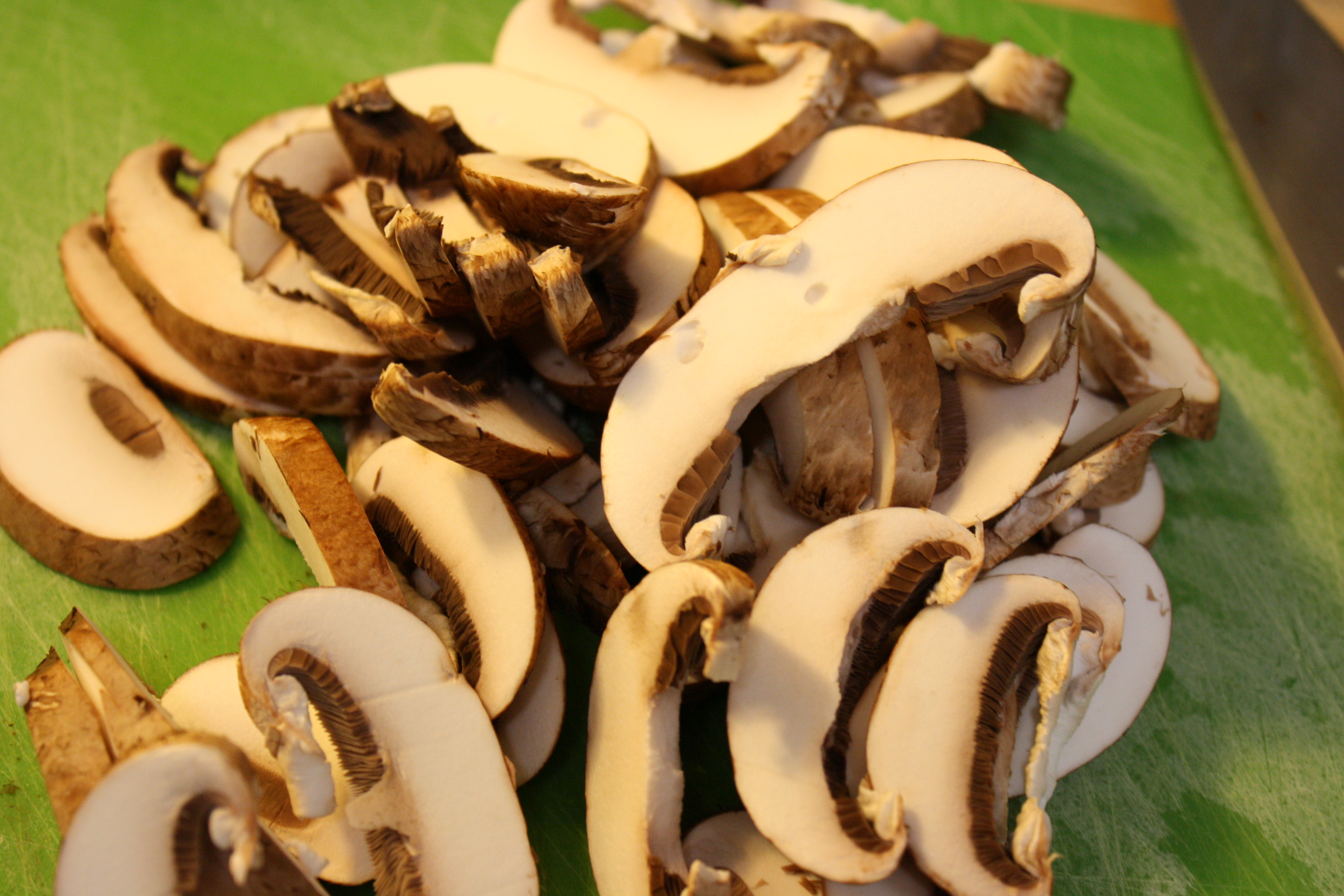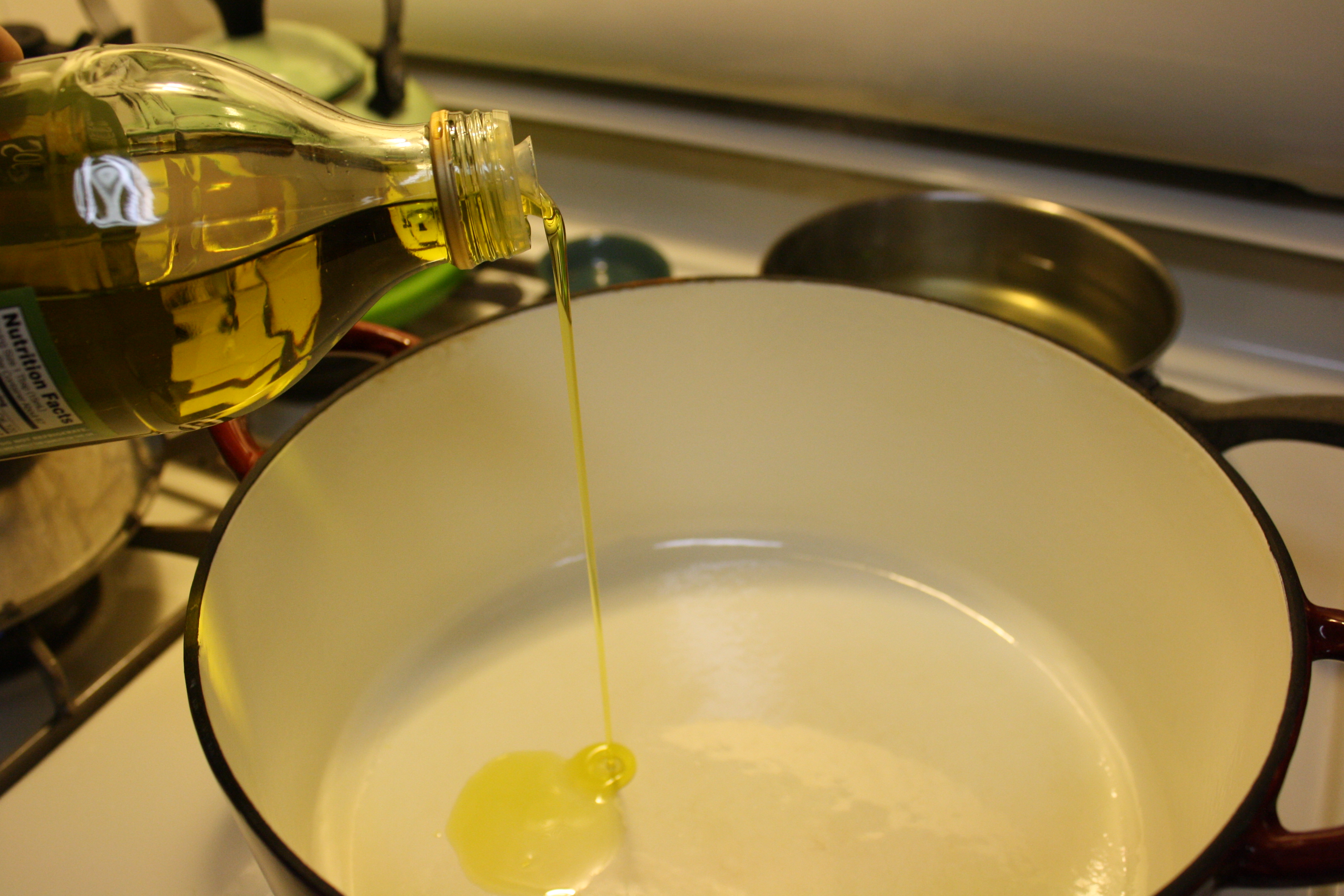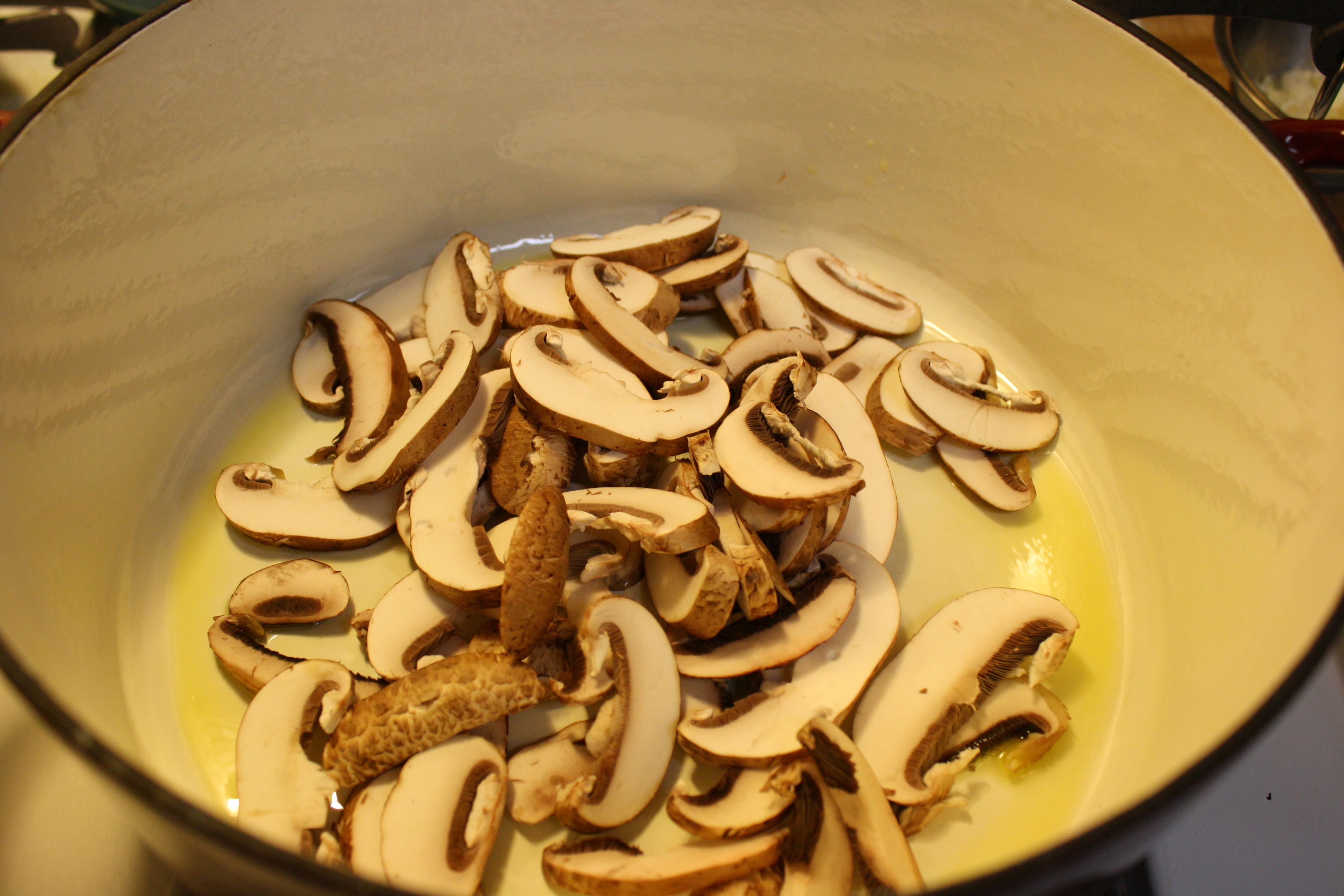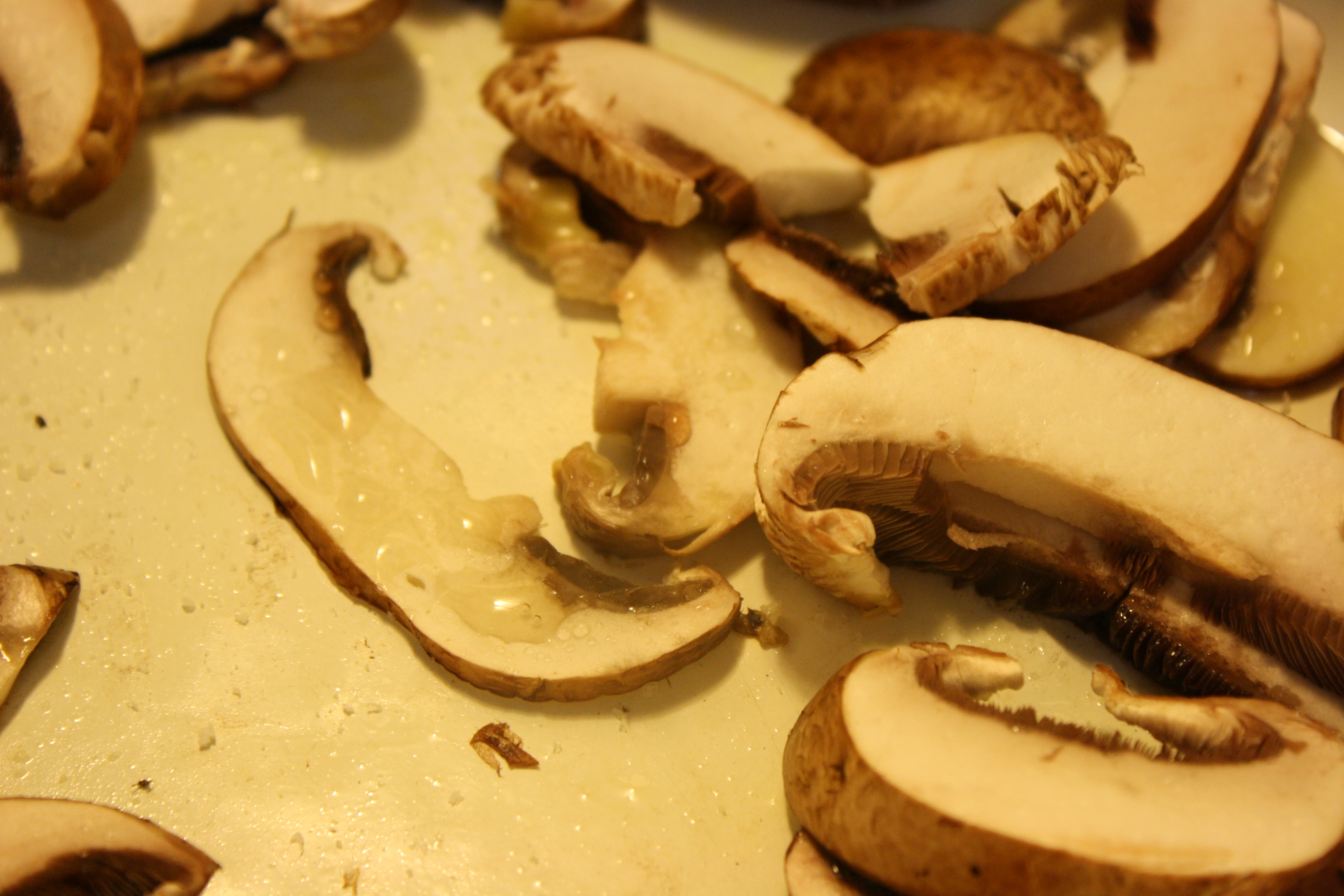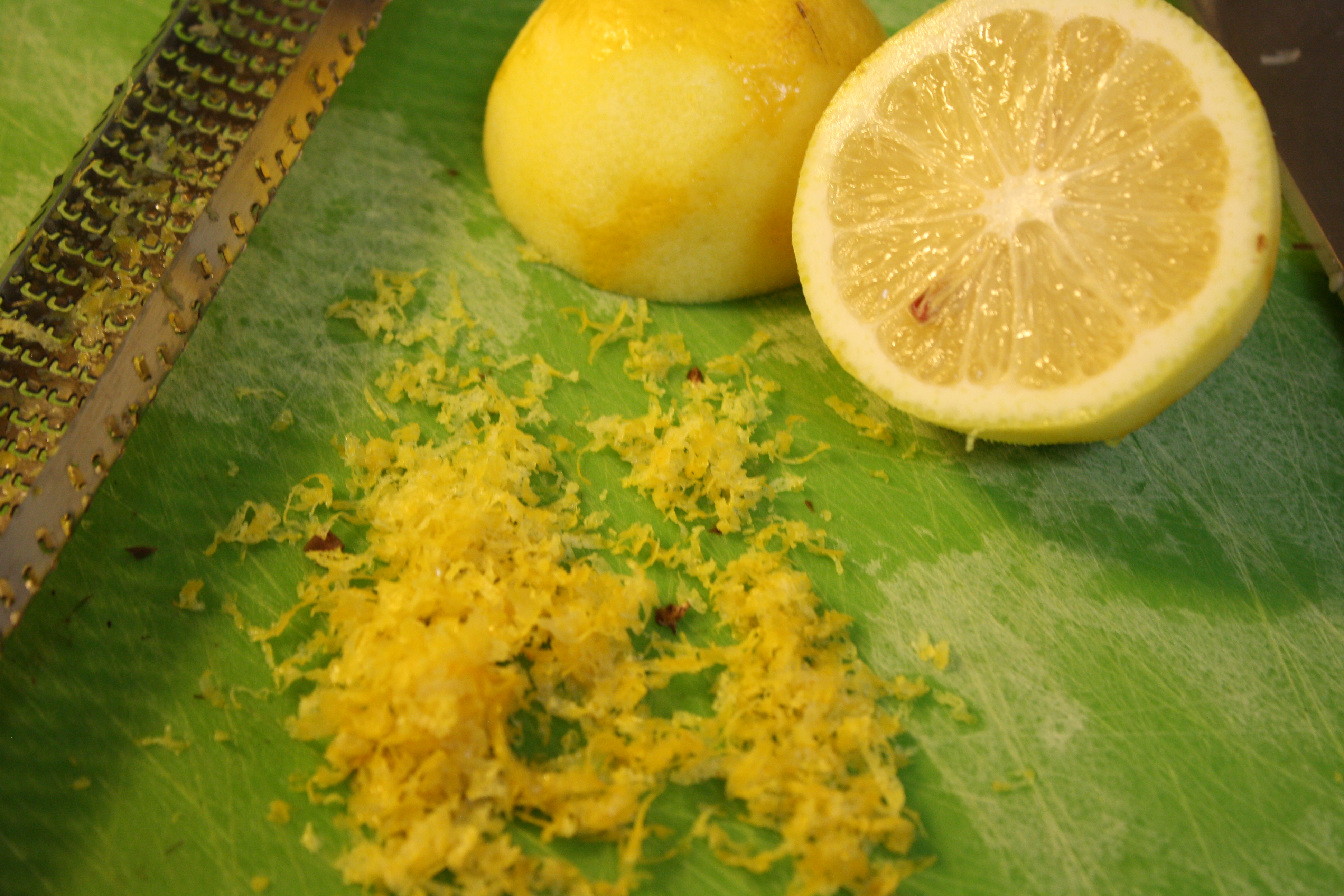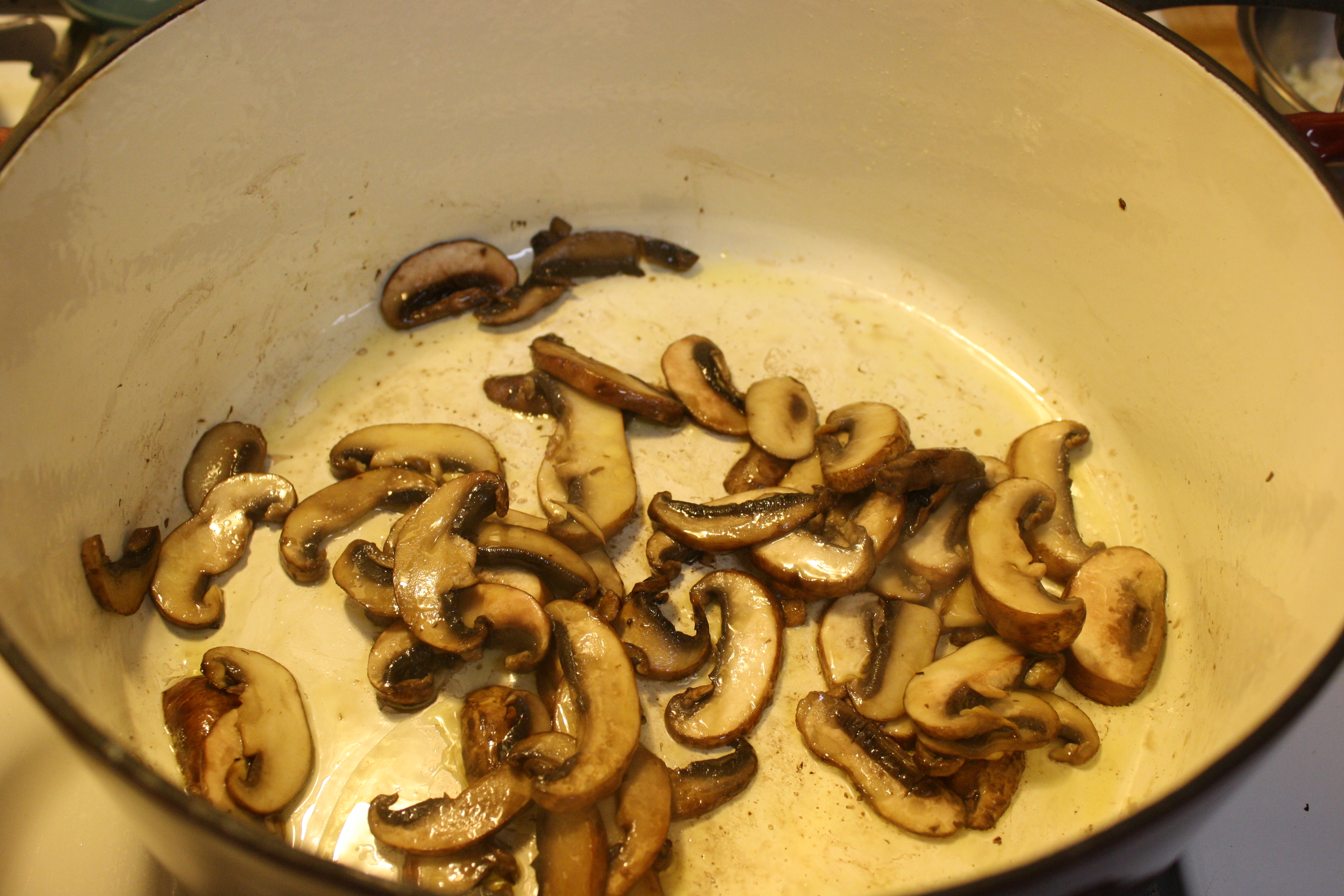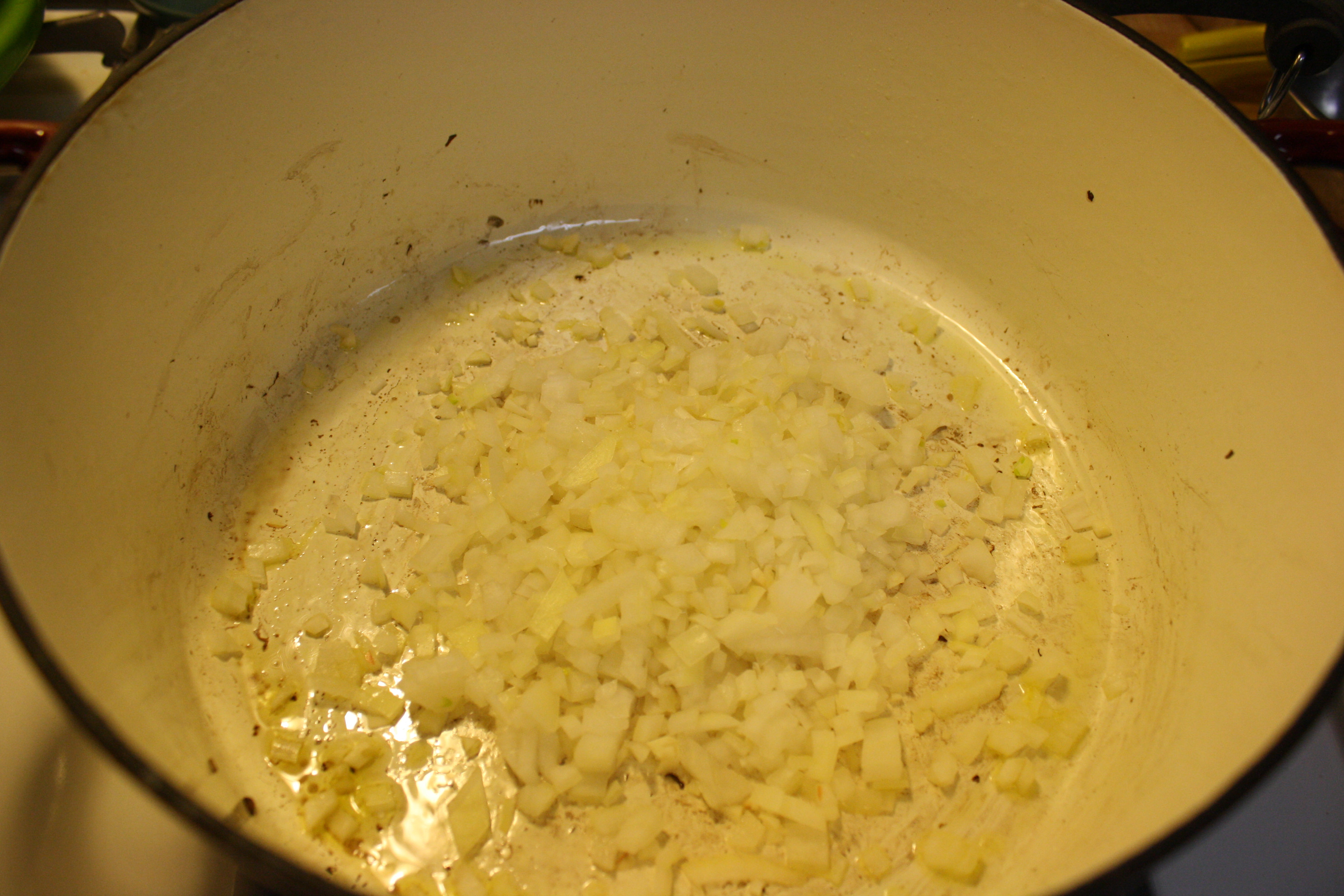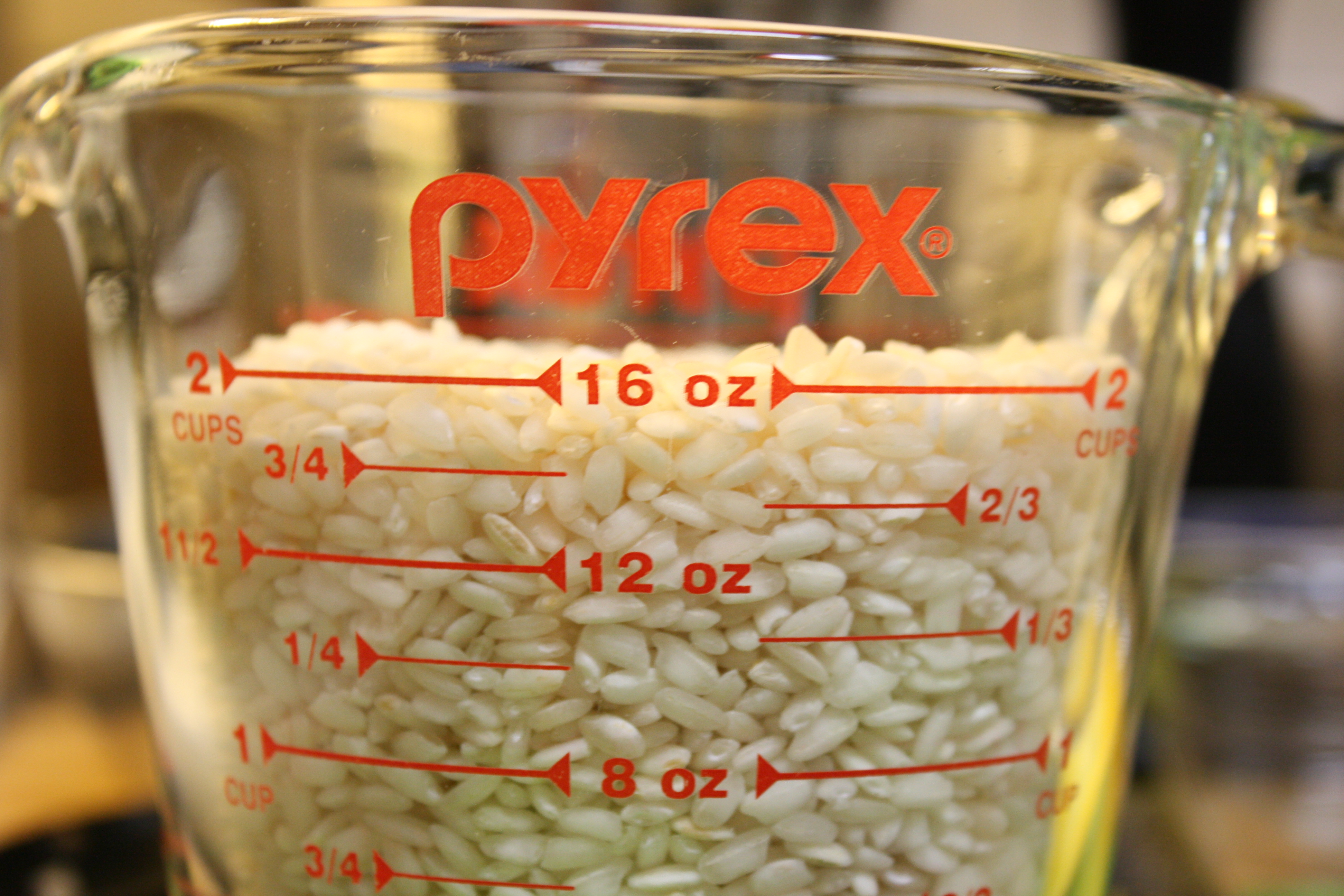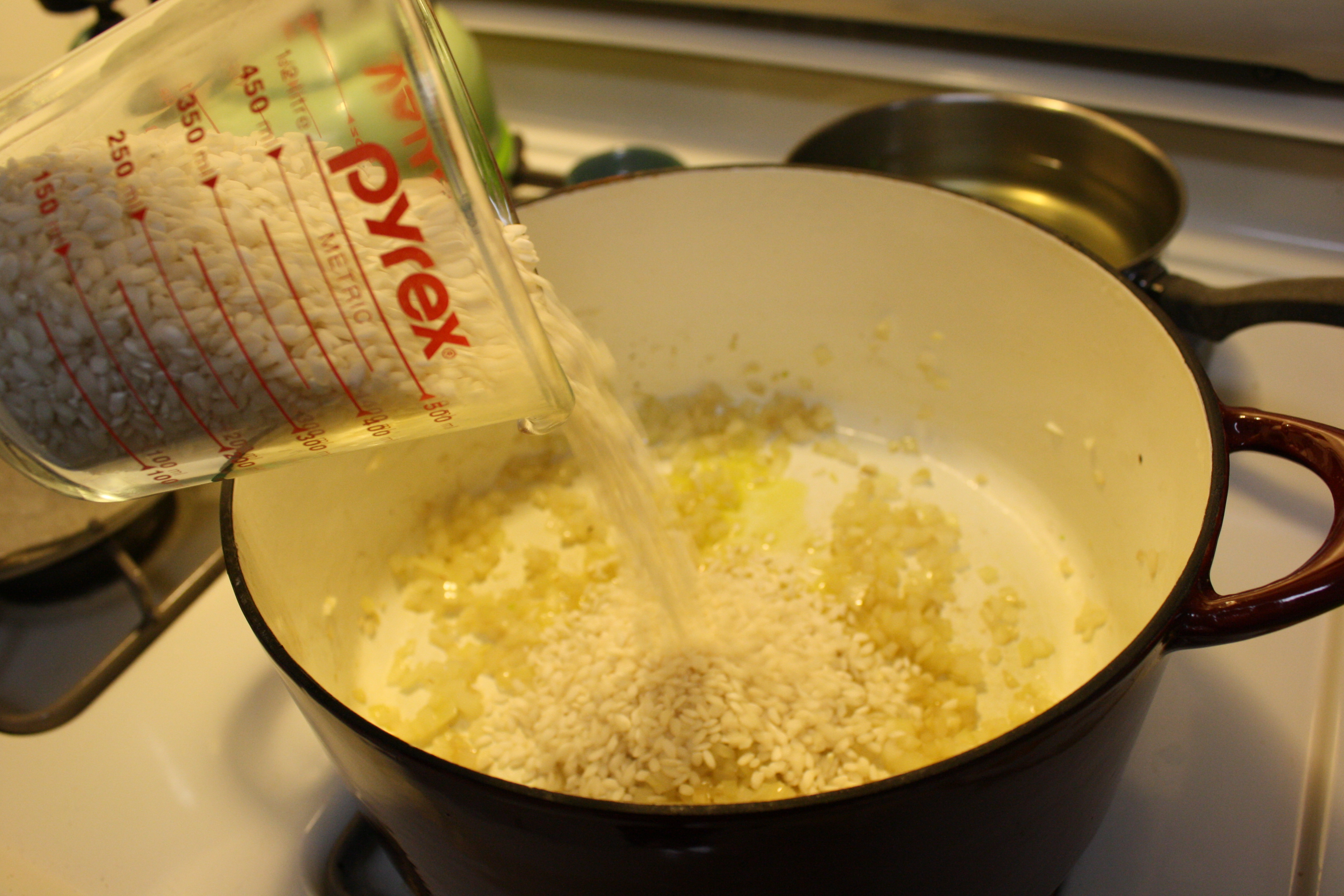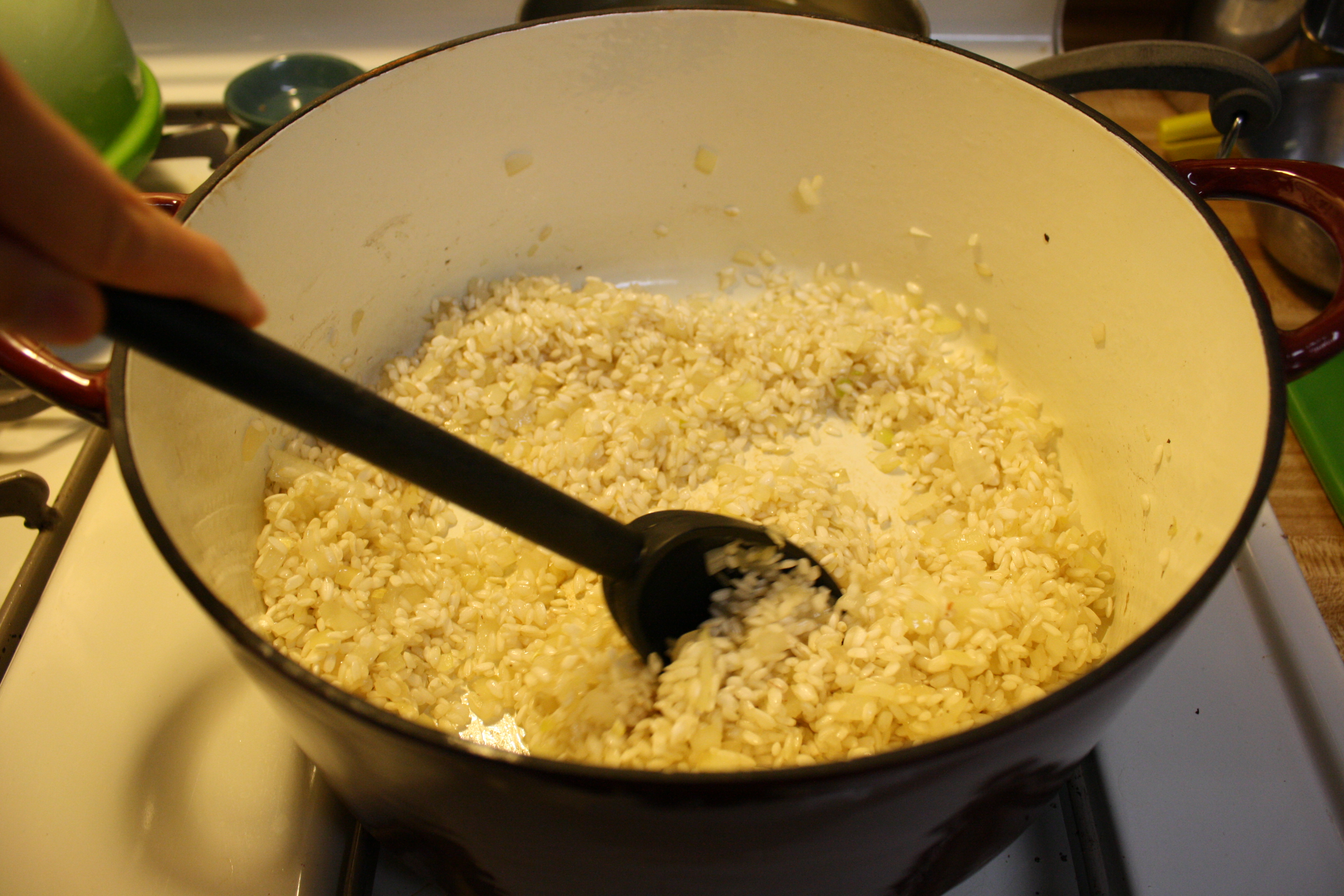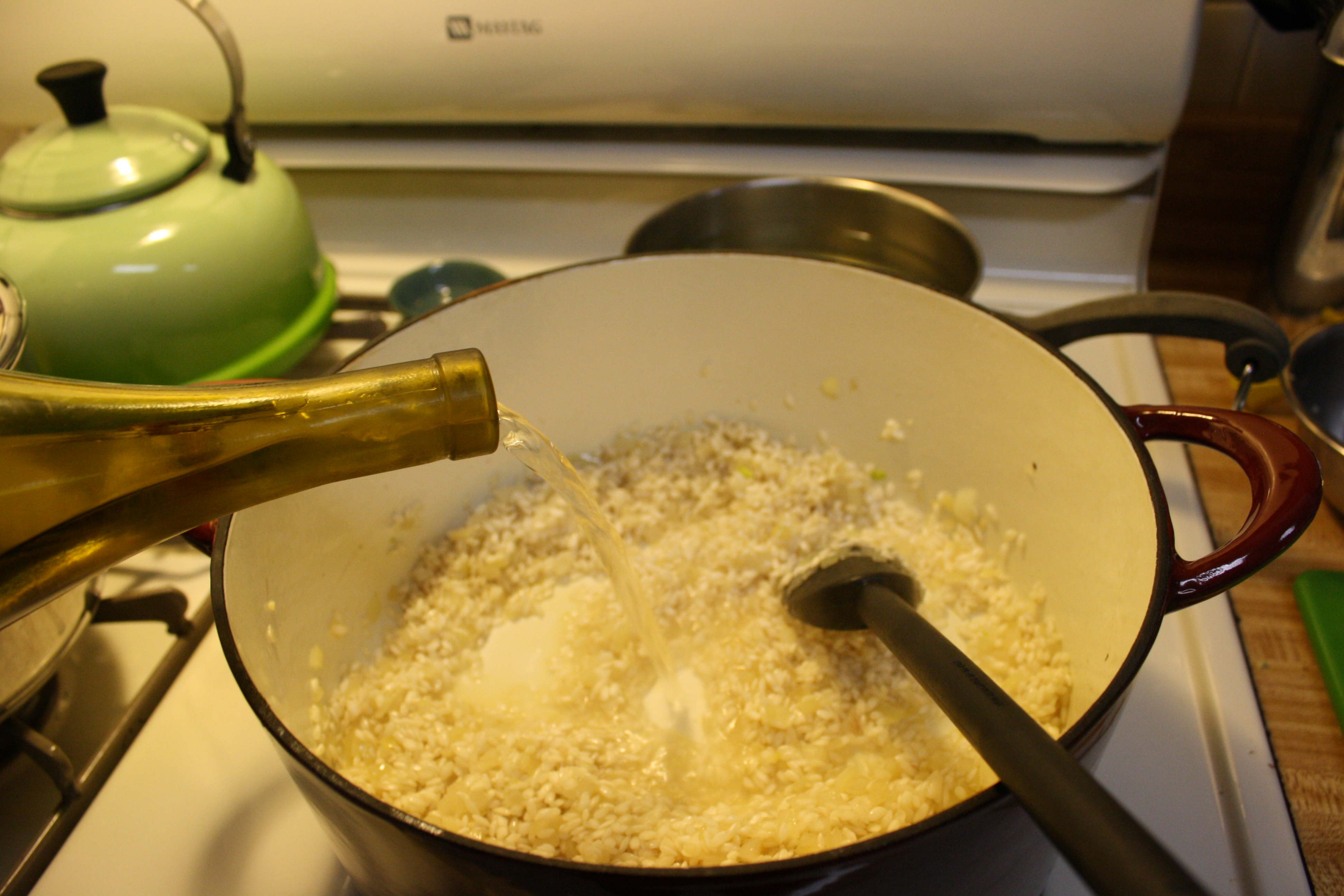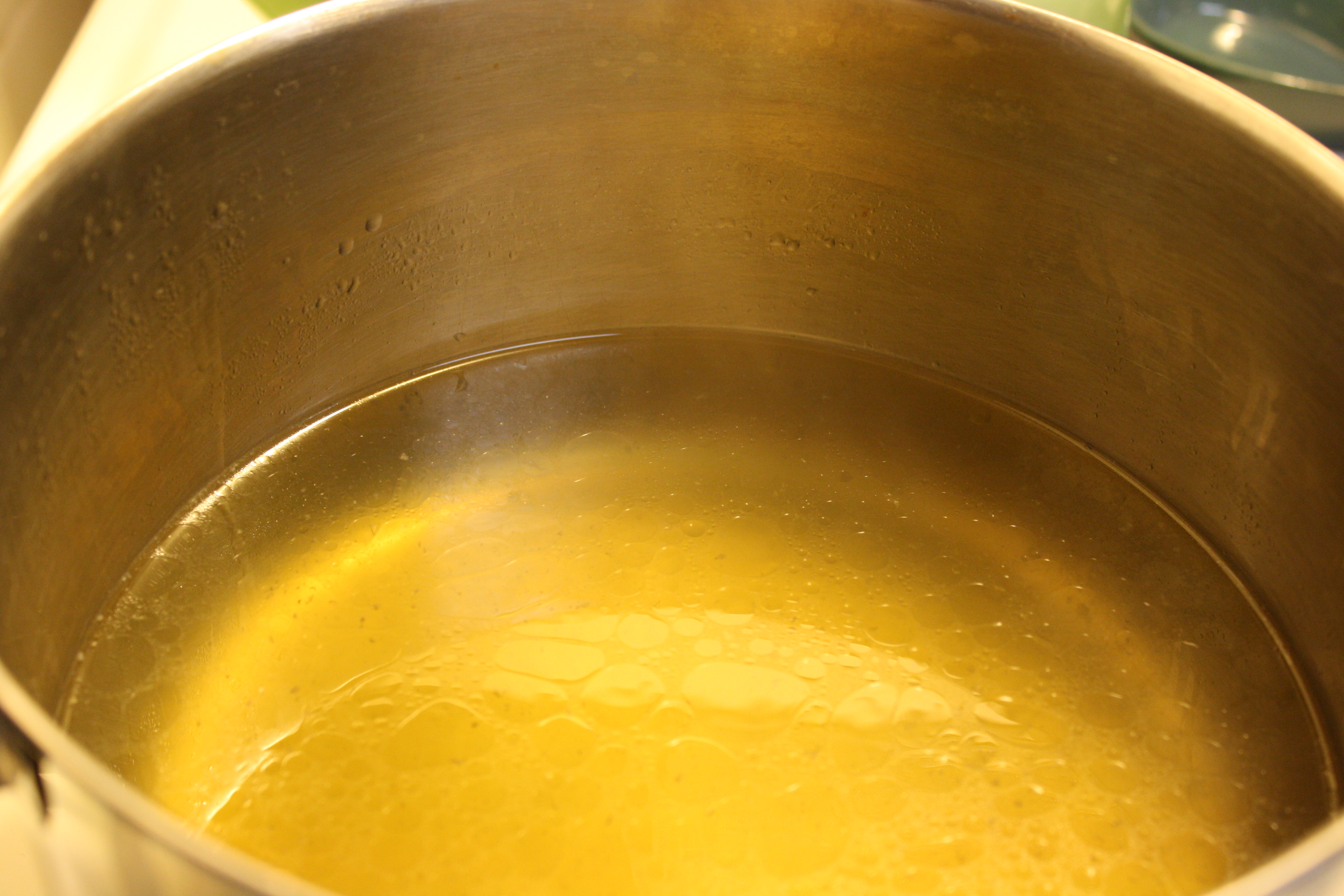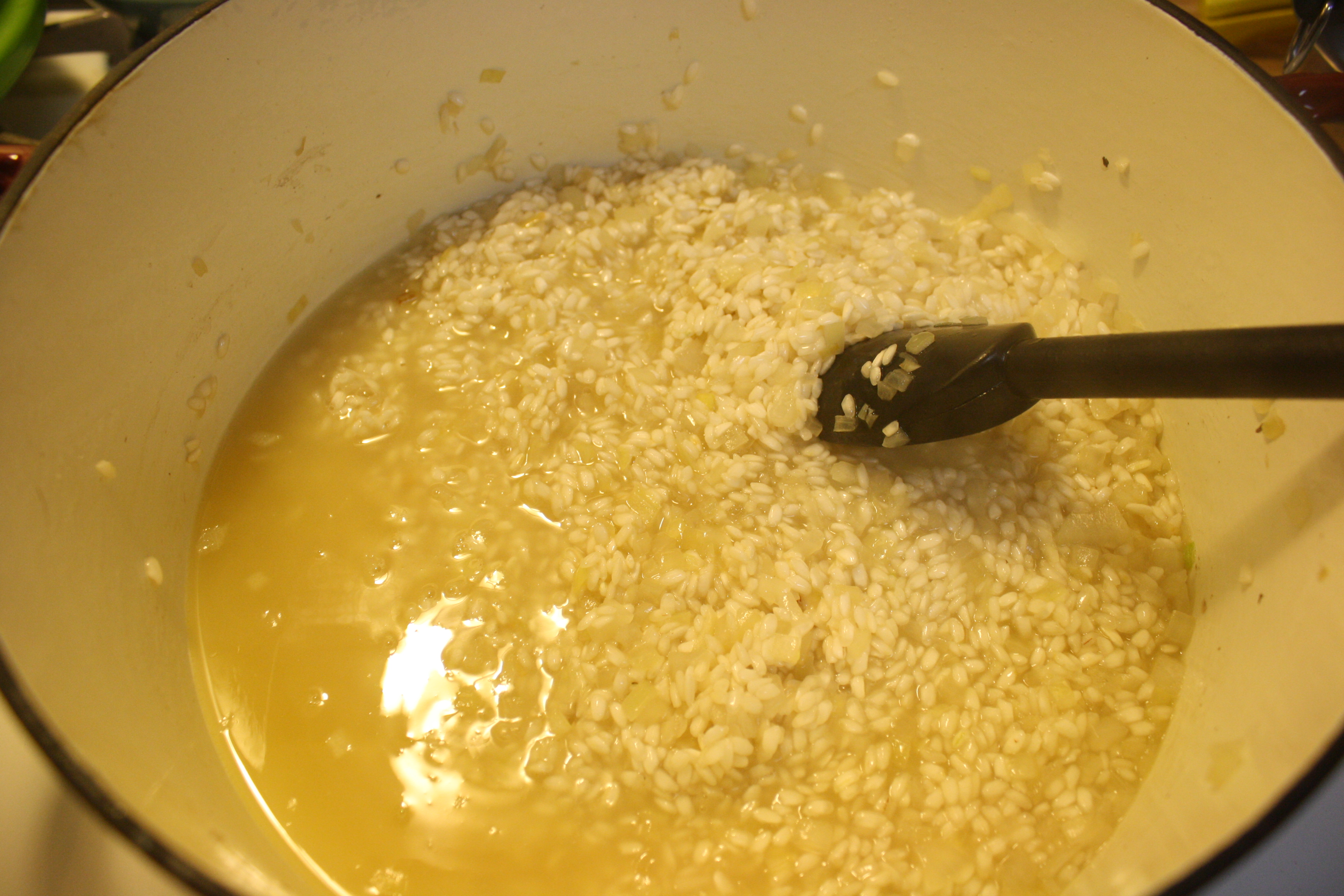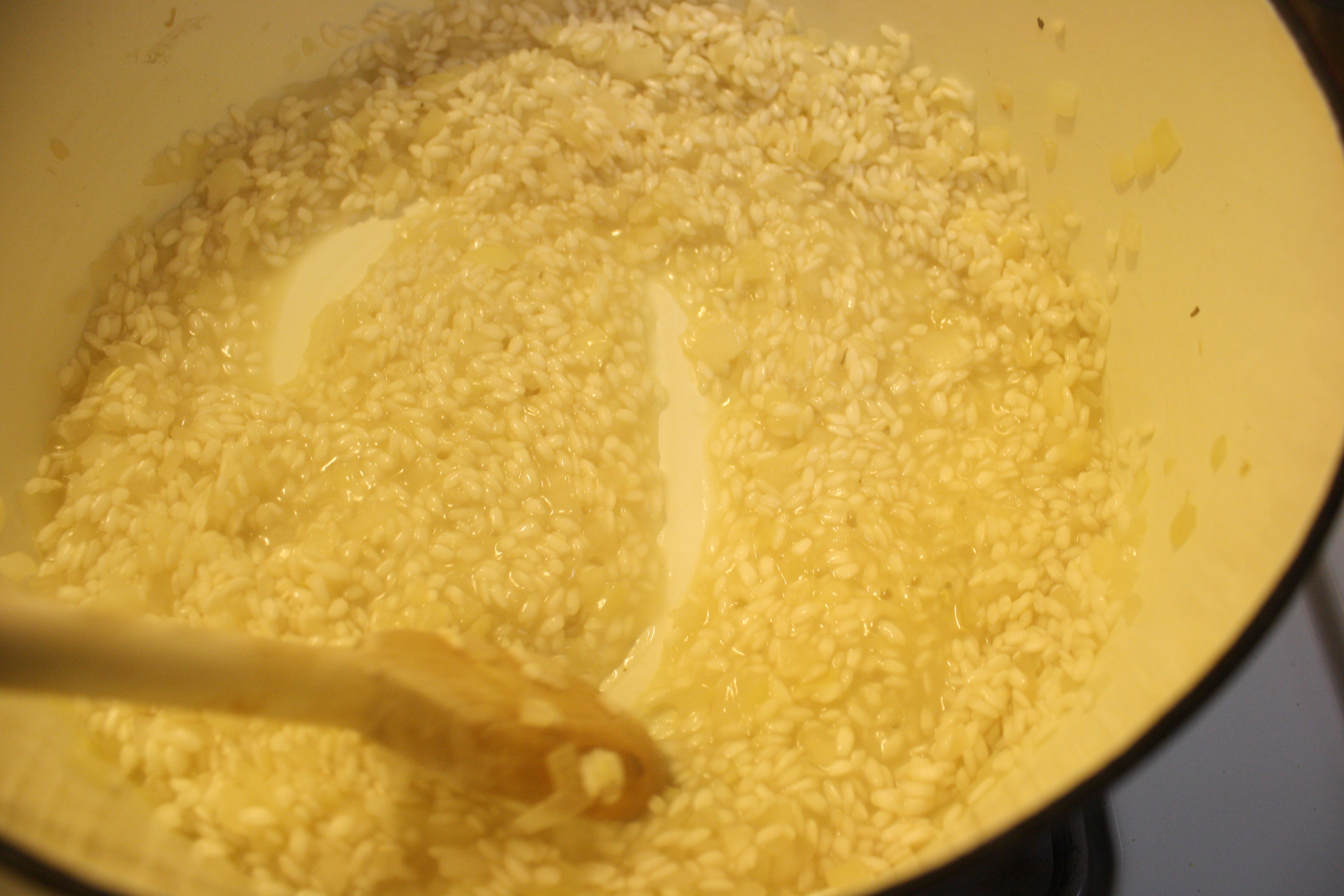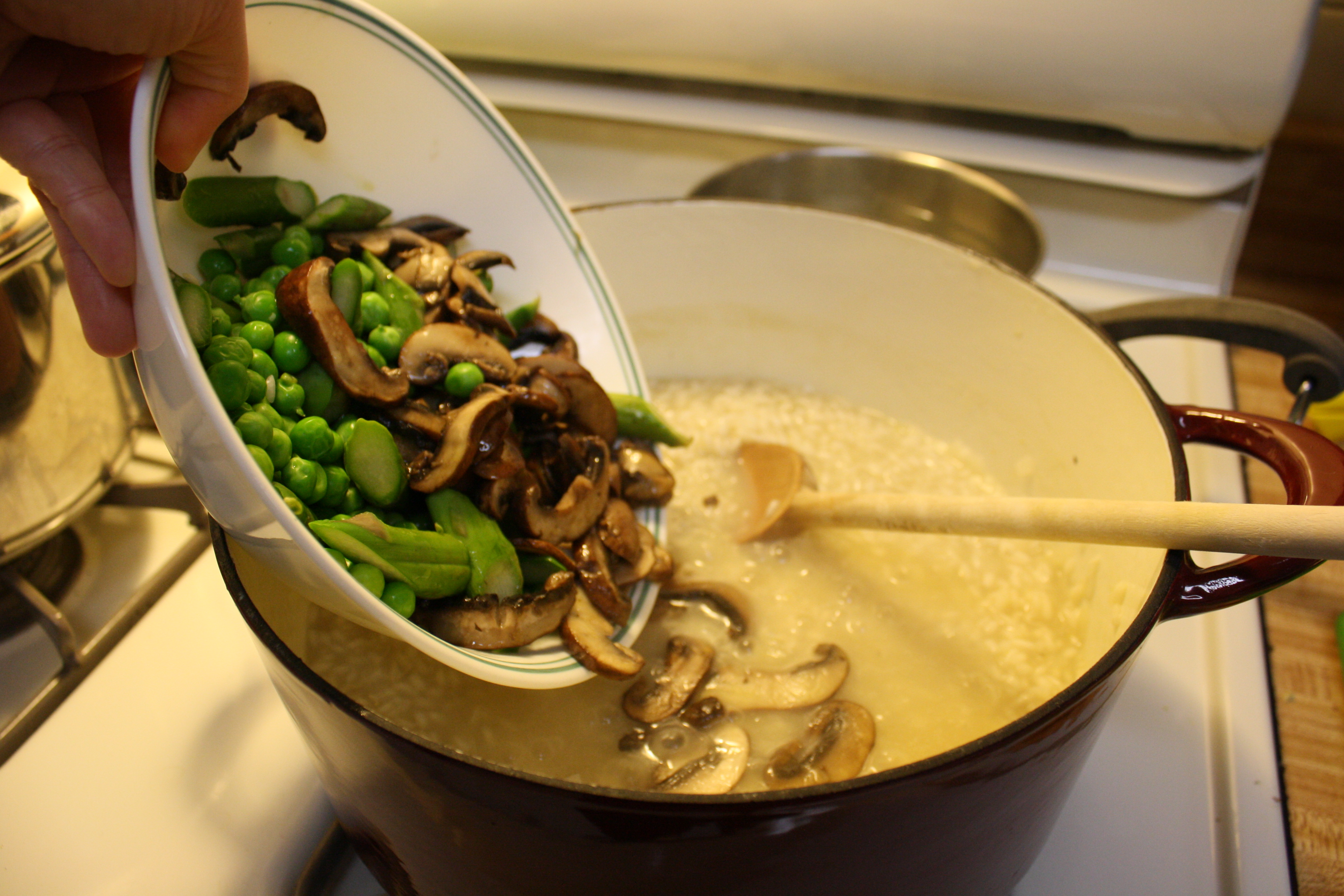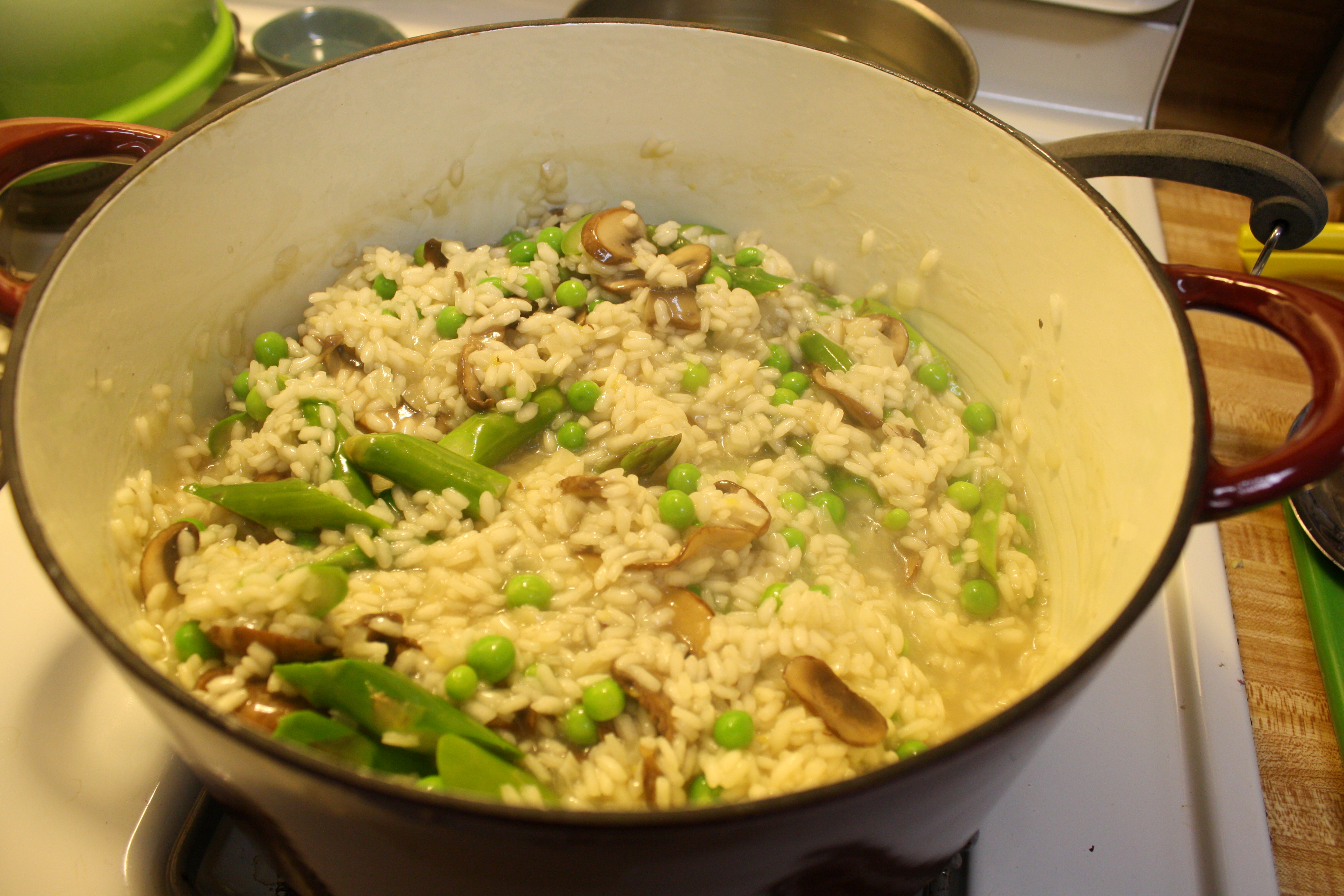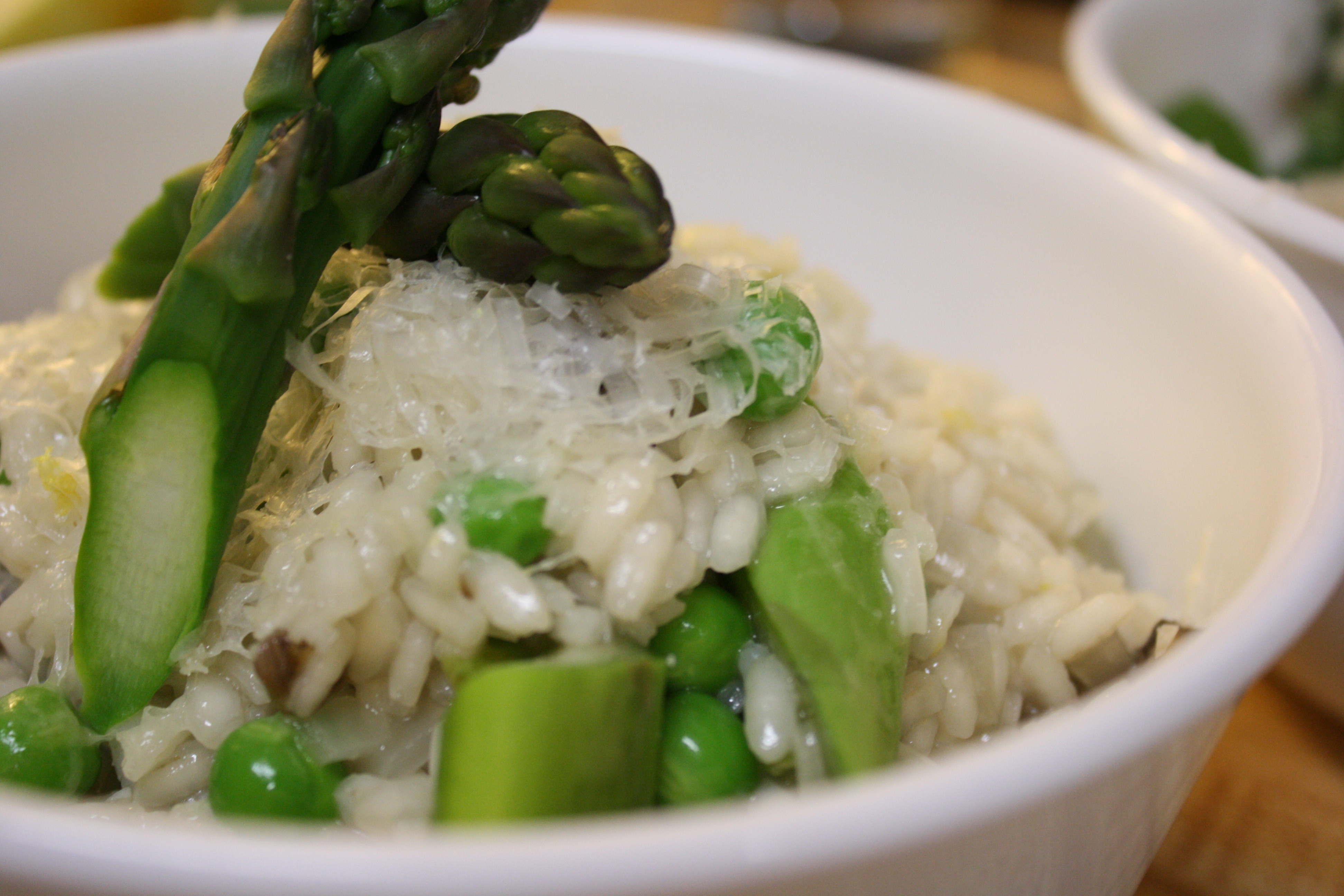This is a post with some seriously good eats. The not so serious part? It’s extremely easy to make, as long as you carve out some time for yourself on a weekend evening, and are totally, 100% committed to putting a lot of love into your food. If you can manage these first two requirements, you can give the gift of risotto to someone special in your life. Even if it’s just yourself.
Back story With a brief warm spell we had last week, a few springtime favorites made an appearance at the market near my house on Saturday: verdant, crisp asparagus spears. Knobbly, plump pea pods. I feel more sprightly just thinking about it. It was a no-brainer to use both in whatever I’d be cooking.
Since Joe was leaving the next afternoon, a big bowl full of risotto love seemed to be the thing that would provide both an appropriate sendoff, and remind him that there’s something (someone?) good to come home to when it’s all said and done.
To throw in an undertone of earthiness with all the vegetal, green flavors, I picked up a few cremini mushrooms to add into the mix. Then, to heighten and brighten all the flavors, lemon zest proved the ticket. Are you ready to see how it all came together? Away we go!
No surprise here. Start with half a yellow onion, and a few cloves of garlic. You’ll want to dice the onion quite finely; same goes for the garlic.
Wanna know something funny? I just realized that more often than not, the photos I shoot of me cooking include this green cutting board. I own approximately 7 cutting boards. I have no idea why this one always gets to model.
Ok, focus. One important thing to know about making risotto is that you must have all the ingredients ready before you start cooking the rice. This means having some stock (or water, but homemade stock is best) waiting, kept warm on the stove. Any garnishes you put into your risotto — in this case, the vegetables, but this could also include meat items like shrimp — must be cooked or at least par-cooked. So, after prepping the aromatics, my next step was to blanch all the vegetables.
First, the peas.
Oh lovely, slightly radioactive looking peas. You look scrumptious. I shall adjust my camera settings so that you look more pea-like, and less like you grew near a nuclear power plant.
Ah, that’s a bit better. Shelling fresh peas is the easiest thing in the world. The pods should be quite crisp, so that you can sort of just pop them open, then strip all the little peas out and into a waiting bowl.
Next, snap the woody, tough ends off each asparagus spear, then cut each spear into 1-1.5 inch long pieces. Cut sharply, on the bias, please.
Now is a great time to get a small or medium sized pot of water onto your stove. Bring it to a gentle boil, and season it with plenty of salt. Then, toss in your asparagus…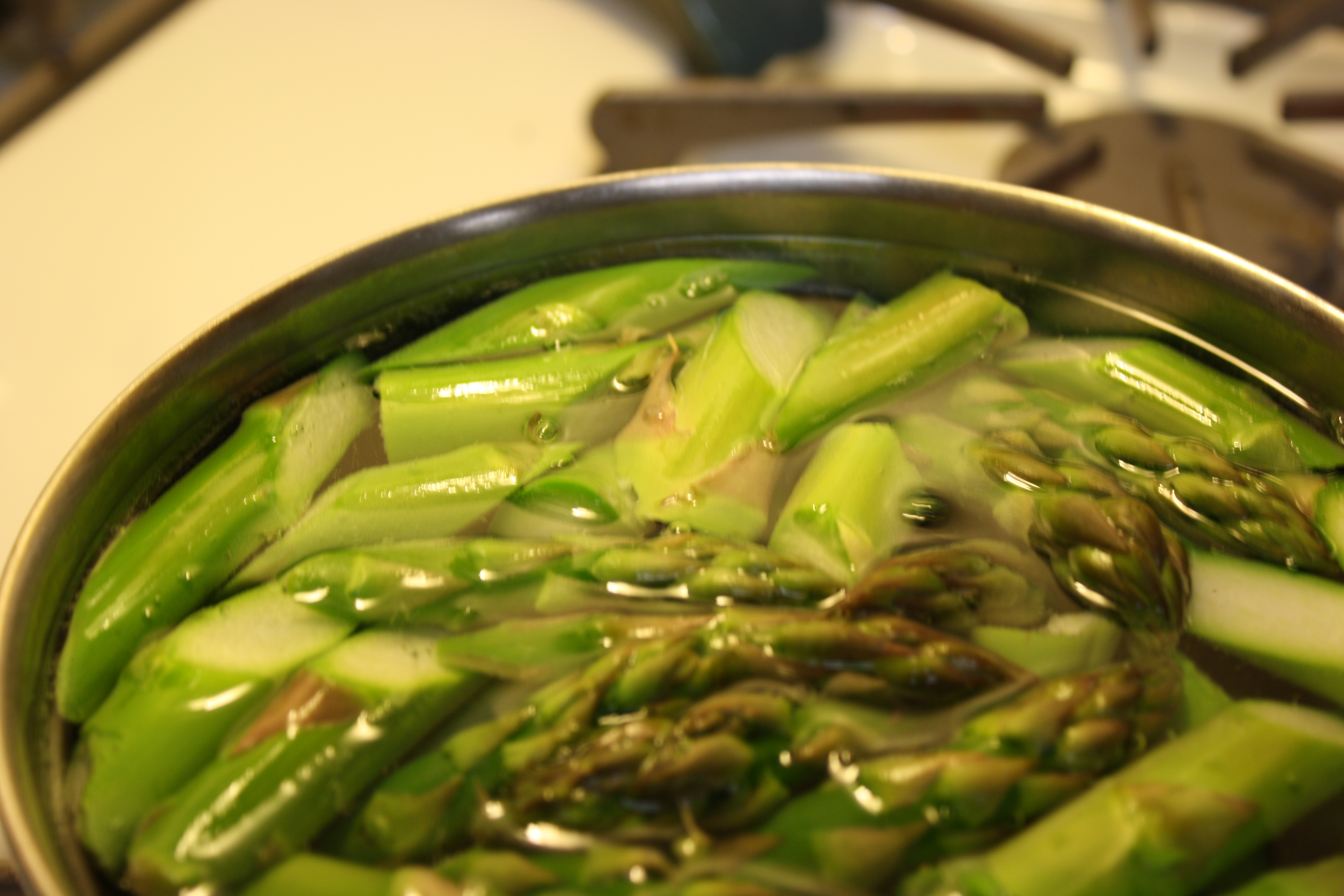
…and adjust your ISO settings so you can get a better shot of the boiling water. Let the asparagus cook in here for a minute or two, until they are just crisp-tender. Remove with a spider or slotted spoon, then toss in the peas:
The peas will need less time than the asparagus. Watch for them to turn bright green. You can always taste one too, and make sure it’s not hard and mealy. But take care — nothing is worse than mushy peas! The peas can also be removed from the water with a spider or slotted spoon, and placed in the same bowl that’s holding your now-cooling asparagus. Set this aside.
Okay, the green vegetable contingent is present and accounted for. We’re almost ready for the star of the show: the rice.
But first, mushrooms. Stem and slice your cremini mushrooms.
Next, in a heavy bottomed pot, heat three or so tablespoons of extra virgin olive oil over medium high heat.
Once it’s good and hot, add in the mushrooms.
Let these cook for a few minutes, without stirring them around all that much. Letting the mushrooms just hang out will give them a better chance to brown. While you’re at it, don’t overcrowd the pot too much. Taking a look at this picture, I probably should’ve browned my mushrooms in two batches. But it was already 7 pm, and Joe kept wandering in and out of the kitchen. You know what that means.
Once the ‘shrooms have been cooking for a few minutes, sprinkle a bit of salt on ’em, and give them a stir. A few minutes after that, if you leave them alone, this is what will happen:
Yup, those granules of kosher salt done pulled the water right out of the mushroom! I love physiology. While the mushrooms cook, zest one whole lemon:
After the mushrooms are good and browned, you can remove them from the pot, and add them right on top of the peas and asparagus. We’ll come back to those guys later.
Okay, now it’s really show time. Add a few more tablespoons of olive oil to your pot (the mushrooms tend to soak up a good bit of the first batch), then dump in the onions and garlic.
Season these, then stir them around for a few minutes until they’re softened and translucent. Since your pot is so hot, this should only take a minute or two. Next up, grab 2 cups of arborio rice. No more, no less.
When the onions and garlic have cooked, pour the rice into the pot, and stir. You’ll want to stir the rice in the fat for a few minutes, to toast it. Once you smell a slightly nutty, cooked grain aroma coming off the rice, you’ll know you’ve done your job. We’re not looking for browning here, just nuttiness.
When you’re good and nutty, it’s time to add the first of the liquids. For us, that’ll mean about half a cup of dry white wine. I used some inexpensive Chardonnay.
The wine will help pick up any leftover fond on the bottom of the pot, as well as give the final dish a bit more richness and depth. Stir this continuously until the liquid is nearly all gone. Then, it’ll be time for chicken stock.
You do have yours next to you on the stove, warmed and at the ready, don’t you?
Excellent. Also, as you can tell from this photo, I never skim my homemade chicken stock of all its fat. I’m bad that way.
Add in a ladleful or two of chicken stock.
Stir the mixture regularly. You’ll quickly notice that the liquid starts to look almost creamy and thick. Also, if you chopped your onions finely enough, they’ll seem to almost melt into the rice.
Keep stirring this mixture gently, until enough liquid has absorbed that you can drag your stirring instrument through the rice without the liquid immediately flowing back into the path you’ve just forged. Sort of like this:
If you’ve ever made pâte à choux, it’s the same concept as adding single eggs into your flour/butter/water mixture. You’re looking for a consistency in which the beater can glide through the dough without it mushing all back together again. A parting of the Red Sea, if you will.
When you reach this point, you can add more stock. Adding the liquid gradually gives the rice time to absorb it, and release the perfect amount of starch to help thicken the risotto. I think the theory here is that if you add too much liquid at once, without giving the grains the proper amount of time to absorb it, you end up with something a bit runny.
The ratio of arborio rice to stock is 1:3. So, since I used 2 cups of rice, I had 6 cups of stock ready to go. Keep adding liquid, stirring, and gauging. With every addition of stock, I added in a pinch of the lemon zest, and also a sprinkling of salt. You’ll need that salt to season the rice as you go along.
Towards the end of your stock additions, begin tasting the rice. It may be that you’ll need a little more or a little less liquid than you need — it all depends on the grains. You’ll also be able to tell whether the whole batch needs more salt.
Once your rice is tender and creamy (but not too soft), add in all the vegetables. But wait! Before you do that, you might want to pull out a few asparagus tips for garnish later.
Fold this mixture gently together, allowing the vegetables to reheat.
Mmmmm. I’m writing this post late at night, and suddenly, I’m hungry again.
Are you ready for the good news? Your risotto is ready to be bowled up. Scoop up a big heap of all that goodness, then garnish it with some pretty asparagus spears and a good dose of parmesan cheese.
I don’t think life really gets much better. The only downside to this recipe, if there is such a thing, is that with so many goodies in the rice, you can’t really use this risotto to make arancini the next day. Unfortunately, that just means you’ll get second helpings at dinner tonight.
Risotto with asparagus, fresh shelling peas, and lemon
- 6 cups homemade chicken stock
- 1 bunch asparagus; washed, woody ends cut off, and cut into 1-1.5″ pieces on the bias
- 1/2 lb fresh shelling peas, peas removed from their pods
- 5 tbsp extra virgin olive oil
- 8-12 large cremini mushrooms, stems removed, cleaned, and cut into 1/8″ slices
- 1/2 medium yellow onion, very finely diced
- 3 small cloves of garlic, minced
- 2 cups arborio rice
- 1/2 cup dry white wine
- 1 organic lemon, washed and zested
- –kosher salt
- –freshly grated parmesan cheese for garnish
- — herbs for garnish (optional)
Heat the chicken stock over medium heat, then reduce to low once steaming. Keep covered, so you don’t lose much of the stock to evaporation.
In a small or medium sized pot, heat plenty of water, and season it with kosher salt. Bring the water to a gentle boil, then add in the asparagus spears. Allow to cook for 2-3 minutes, until crisp tender. Remove to a large bowl with a large slotted spoon or bamboo spider. Add in the peas to the same water; cook for 1-2 minutes, then remove with a slotted spoon to the same bowl as the asparagus. Remove the water from the heat.
In a large, heavy bottomed Dutch oven, heat 3 tbsp of the olive oil. Once hot, add in the sliced mushrooms. Allow to cook in the fat for a 3-4 minutes, until they are beginning to wilt and brown. Season with kosher salt, and stir. Allow to sit for a few more minutes and continue browning. Remove from the pot, and add to the asparagus/pea bowl.
Pour in the remaining 2 tbsp of olive oil. Add in the onions and garlic, and stir. Season with kosher salt. Once softened and translucent, add in the arborio rice. Stir for approximately 3 minutes, until the rice is fragrant and nutty.
Next, pour in the white wine, and stir until almost entirely absorbed. In one to two ladle increments, add in the warm chicken stock, stirring in between additions until most of the liquid is absorbed and the risotto is beginning to look creamy. Add in bits of the lemon zest and kosher salt along with each addition of stock. As a general rule, you should be able to drag your spoon through the risotto mixture and be able to forge a path before adding the next batch of stock. Once you have only a cup or so of stock left, be sure to taste your risotto to see if it needs it.
Once the rice is cooked through, pour in all of the vegetables, and gently fold together in the risotto. Allow the vegetables to reheat in the mixture (and finish cooking if necessary — though the vegetables should already be 95% cooked). Bowl up the risotto, and garnish with asparagus spears, herbs or parmesan cheese — or all three if you’d like.
